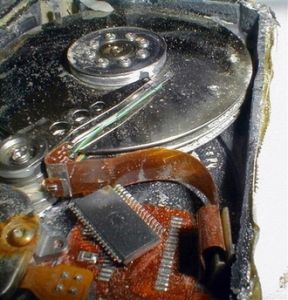From our front-page news:
I have no doubts that every single person reading this has at some point lost data that should have been kept. Curses the Recycle Bin for making it so easy, I say. Happily though, the data is often recoverable with relatively inexpensive programs (such as R-Studio which I've found to be fantastic in the past), but that's only possible if it's a software issue. Once it's a hardware issue, it's much, much more difficult to recover.
We've all heard impressive stories about recovery, but nothing can match this. When the disastrous Columbia shuttle exploded close to landing in 2003, debris scattered all over. By some estimates, debris pieces could have totaled 20,000, and most appeared in more than one US state. So what's the chance of a hard drive dropping 60KM from the sky after such an ordeal and still survive?
Well in some sort of miracle, such a drive did manage to survive, and 99% of the data was recovered by Ontrack. This is made even more impressive because some parts of the drive were dented, but all of the data was recorded in the good areas. Even more impressive is the fact that the drive ran DOS, but that's the reason so much data was recoverable. Unlike NTFS, which scatters data all over the place, FAT stores it sequentially, which is the prime reason for the 99% figure.
<table align="center"><tbody><tr><td>

</td></tr></tbody></table>
Edwards had reason for pessimism. Not only were the drive's metal and plastic elements scorched, but the seal on the side that keeps out dirt and dust also had melted. That made the drive vulnerable to particles that can scratch the tiny materials embedded inside, destroying their ability to retain data in endless 0s or 1s, depending on their magnetic charge.
Source: Yahoo! News
We've all heard impressive stories about recovery, but nothing can match this. When the disastrous Columbia shuttle exploded close to landing in 2003, debris scattered all over. By some estimates, debris pieces could have totaled 20,000, and most appeared in more than one US state. So what's the chance of a hard drive dropping 60KM from the sky after such an ordeal and still survive?
Well in some sort of miracle, such a drive did manage to survive, and 99% of the data was recovered by Ontrack. This is made even more impressive because some parts of the drive were dented, but all of the data was recorded in the good areas. Even more impressive is the fact that the drive ran DOS, but that's the reason so much data was recoverable. Unlike NTFS, which scatters data all over the place, FAT stores it sequentially, which is the prime reason for the 99% figure.
<table align="center"><tbody><tr><td>

</td></tr></tbody></table>
Edwards had reason for pessimism. Not only were the drive's metal and plastic elements scorched, but the seal on the side that keeps out dirt and dust also had melted. That made the drive vulnerable to particles that can scratch the tiny materials embedded inside, destroying their ability to retain data in endless 0s or 1s, depending on their magnetic charge.
Source: Yahoo! News
